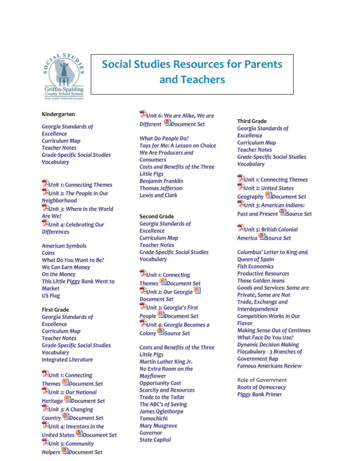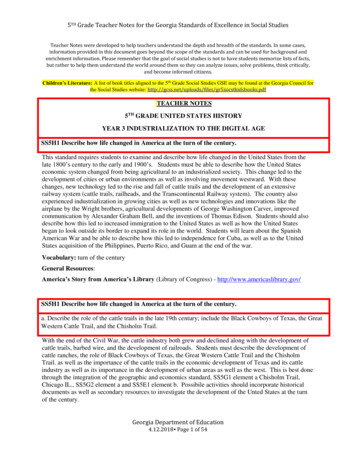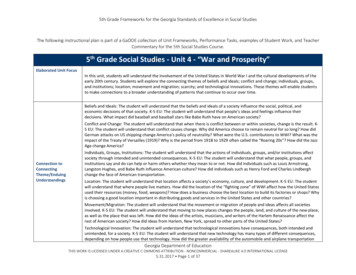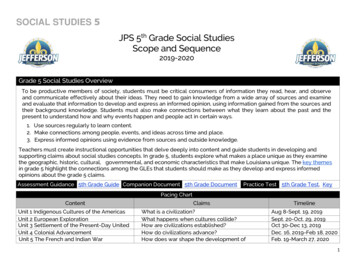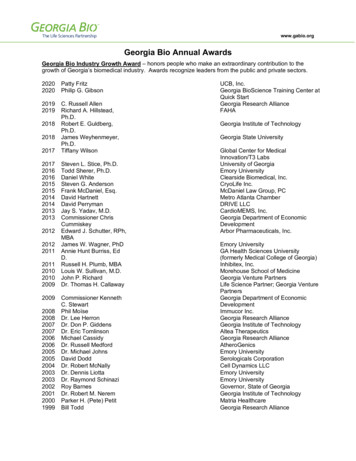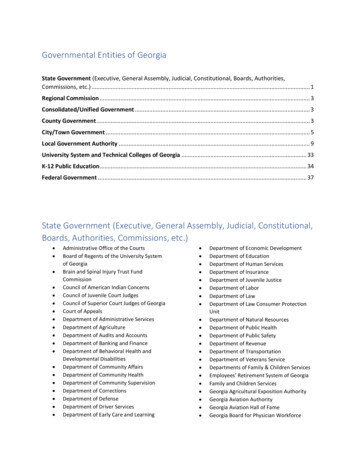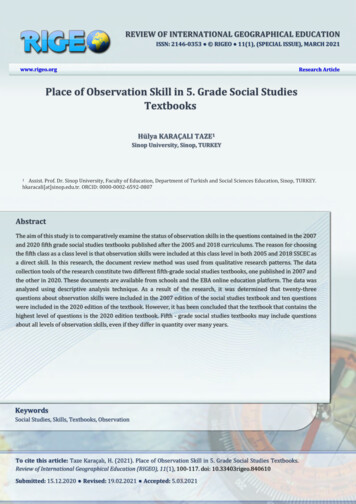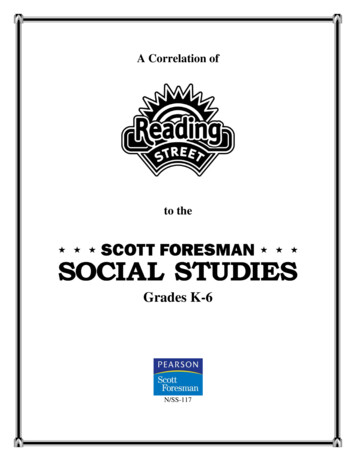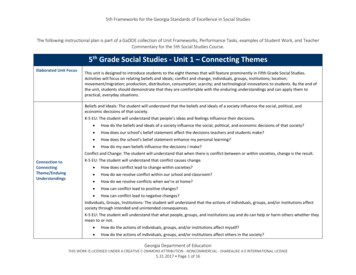
Transcription
5th Frameworks for the Georgia Standards of Excellence in Social StudiesThe following instructional plan is part of a GaDOE collection of Unit Frameworks, Performance Tasks, examples of Student Work, and TeacherCommentary for the 5th Social Studies Course.5th Grade Social Studies - Unit 1 – Connecting ThemesElaborated Unit FocusThis unit is designed to introduce students to the eight themes that will feature prominently in Fifth Grade Social Studies.Activities will focus on relating beliefs and ideals; conflict and change; individuals, groups, institutions; location;movement/migration; production, distribution, consumption; scarcity; and technological innovations to students. By the end ofthe unit, students should demonstrate that they are comfortable with the enduring understandings and can apply them topractical, everyday situations.Beliefs and Ideals: The student will understand that the beliefs and ideals of a society influence the social, political, andeconomic decisions of that society.K-5 EU: The student will understand that people’s ideas and feelings influence their decisions. How do the beliefs and ideals of a society influence the social, political, and economic decisions of that society? How does our school’s belief statement affect the decisions teachers and students make? How does the school’s belief statement enhance my personal learning? How do my own beliefs influence the decisions I make?Conflict and Change: The student will understand that when there is conflict between or within societies, change is the result.Connection toConnectingTheme/EnduingUnderstandingsK-5 EU: The student will understand that conflict causes change. How does conflict lead to change within societies? How do we resolve conflict within our school and classroom? How do we resolve conflicts when we’re at home? How can conflict lead to positive changes? How can conflict lead to negative changes?Individuals, Groups, Institutions: The student will understand that the actions of individuals, groups, and/or institutions affectsociety through intended and unintended consequences.K-5 EU: The student will understand that what people, groups, and institutions say and do can help or harm others whether theymean to or not. How do the actions of individuals, groups, and/or institutions affect myself? How do the actions of individuals, groups, and/or institutions affect others in the society?Georgia Department of EducationTHIS WORK IS LICENSED UNDER A CREATIVE C OMMONS ATTRIBUTION - NONCOMMERCIAL - SHAREALIKE 4.0 INTERNATIONAL LICENSE5.31.2017 Page 1 of 16
5th Frameworks for the Georgia Standards of Excellence in Social StudiesLocation: The student will understand that location affects a society’s economy, culture, and development.K-5 EU: The student will understand that where people live matters. How does location affect society’s economy, culture, and development?Movement/Migration: The student will understand that the movement or migration of people and ideas affects all societiesinvolved.K-5 EU: The student will understand that moving to new places changes the people, land, and culture of the new place, as wellas the place that was left. How are societies affected by the movement or migration of people and ideas? Why do people move to new places? How do people change when they move to a new place?Production, Distribution, and Consumption: The student will understand that the production, distribution, and consumption ofgoods/services produced by the society are affected by the location, customs, beliefs, and laws of the society.K-5 EU: The student will understand that the ways people make, get, and use goods and services may be different from howpeople in other places make, get, and use goods and services. How do societies decide what goods and services to produce, distribute, and consume? Why are those goods and services important to that community?K-5 EU: The student will understand that scarcity of all resources forces parties to make choices and that these choices alwaysincur a cost. Why can’t we all have everything we want? How does scarcity affect our everyday lives?Technological Innovation: The student will understand that technological innovations have consequences, both intended andunintended, for a society.K-5 EU: The student will understand that new technology has many types of different consequences, depending on how peopleuse that technology.GSE for Social Studies How does technology change society? What is technology? What are the positive and negative consequences of technology? How does the technology in our classroom influence the way we learn? How does technology affect the way we live our lives when we are not as school?This unit is designed to teach the themes used in the course. There are no standards and elements for this introductory unit.Georgia Department of EducationTHIS WORK IS LICENSED UNDER A CREATIVE C OMMONS ATTRIBUTION - NONCOMMERCIAL - SHAREALIKE 4.0 INTERNATIONAL LICENSE5.31.2017 Page 2 of 16
5th Frameworks for the Georgia Standards of Excellence in Social StudiesGSE forELA/Science/MathThis unit is designed to teach the themes used in the course. There are no standards and elements for this introductory unit.Connection to SocialStudies Matrices(informationprocessing and/or mapand globe skills)Information Processing Skills: identify issues and/or problems and alternative solutions draw conclusions and make generalizations construct charts and tablesEssential Questions and Related Supporting/Guiding Questions1.Essential Question 1How can Social Studies themes be found in my everyday life?a.How do I experience the connecting themes at school and in my community?b.What are the different Social Studies themes and why are they important?c.How will these connecting themes be detected in the different units we will study this year?Georgia Department of EducationTHIS WORK IS LICENSED UNDER A CREATIVE C OMMONS ATTRIBUTION - NONCOMMERCIAL - SHAREALIKE 4.0 INTERNATIONAL LICENSE5.31.2017 Page 3 of 16
5th Frameworks for the Georgia Standards of Excellence in Social StudiesSample Instructional Activities/AssessmentsBeliefs and IdealsDescription –1.Have students discuss the school’s vision and beliefs as a class2.Discuss the meaning of each part and the reason why the school has a belief statement3.Move to small groups to create a list of their own beliefs about learning. For example, “We believe that if we work hard, we will learn what weneed to know to do well in 5th grade and beyond.”4.Once students have had time to create lists in small groups, create a class chart of the ideas.5.Using this chart, students should identify the most important ideas and use these ideas to compose a class belief statement. This should bedisplayed in the classroom for the rest of the year.6.Students should then write about the contents of the class belief statement and how that will affect their decisions over the course of the year.GSE Standards andElementsLiteracy StandardsSocial Studies MatricesEnduringUnderstanding(s)This unit is designed to teach the themes used in the course. There are no standards and elements for this introductory unit.Information Processing Skills: identify issues and/or problems and alternative solutionsGeorgia Department of EducationTHIS WORK IS LICENSED UNDER A CREATIVE C OMMONS ATTRIBUTION - NONCOMMERCIAL - SHAREALIKE 4.0 INTERNATIONAL LICENSE5.31.2017 Page 4 of 16
5th Frameworks for the Georgia Standards of Excellence in Social StudiesConflict and ChangeDescription –1.Read a picture book or short story in which characters experience an interpersonal conflict.2.After reading the book, discuss the events that lead up to the conflict, how the conflict was resolved, and how the characters changed as a resultof the conflict3.Break students into small groups and give them one of the attached conflict scenarios to role play for the class4.The first time they role play the situation, they should show a negative change as a result of the conflict. For example, students who are arguingover playground equipment might choose to get rid of the equipment completely to resolve the conflict.5.Students should role play the same situation again, but this time, they should show a positive change as a result of the conflict. For example,students who are arguing over playground equipment might choose to organize team sports so that everyone can use the equipment together.6.Create a class chart and complete the chart as students role play their situations for the class7.Allow students to share their own experiences from school or home in which a conflict led to a positive or negative change8.Add these examples to the chartFile belowGSE Standards andElementsLiteracy StandardsSocial Studies MatricesEnduringUnderstanding(s)This unit is designed to teach the themes used in the course. There are no standards and elements for this introductory unit.Information Processing Skills: identify issues and/or problems and alternative solutions construct charts and tablesGeorgia Department of EducationTHIS WORK IS LICENSED UNDER A CREATIVE C OMMONS ATTRIBUTION - NONCOMMERCIAL - SHAREALIKE 4.0 INTERNATIONAL LICENSE5.31.2017 Page 5 of 16
5th Frameworks for the Georgia Standards of Excellence in Social StudiesConflict CardsIt’s time to form groups to work on a project. Theteacher said you can make groups of 2 or 3, but nomore. You quickly rush to join your two best friendsbecause you know you work very well together. Youglance up and see another friend looking very sadwithout a partner. What will you do?At recess, a big group of kids have gathered to playkickball. A few kids who don’t usually play have joinedteams, too. One of these students comes up to kick andtrips over the ball as it comes to him. What will you do?You’re just about to leave the bathroom when yourbest friend comes in. He says his brother told himabout a prank some kids played in middle school. Theytook the toilet paper off the rolls and threw it all overthe bathroom. They didn’t get caught, but all the restof the kids know they did it and think it was reallyfunny. He wants to do the same thing now. What willyou do?The class is working on a watercolor project. Your tablehas four sets of watercolors. Most of them are old and allthe colors have run together, but one set is brand new.Everyday, one student at your table grabs all thewatercolors and finds the new one, then puts the restback on the table for everyone else. What will you do?When it’s time to line up for lunch, your best friendalways cuts in line to stand by you. He talks to you thewhole way down the hall and sometimes you get introuble for it. What will you do?Three girls from your Girl Scout troop are in your class.They’re your good friends, but two of them have gotteninto a big fight and aren’t talking to each other anymore.They have both asked you to stop being friends with theother girl. What will you do?Your class has one kickball and a few jump ropes forstudents to share during recess. Everyday when you gooutside, the same students grab the equipment leavingeveryone else with nothing to do. What will you do?You are the last one to come back from art class. Whenyou sit down at your desk, you realize that your brandnew mechanical pencil is gone. You search everywhereand can’t find it. Later on, you realize that the studentsitting behind you is using the same kind of pencil. Youask him about it, but he says it is his. What will you do?Georgia Department of EducationTHIS WORK IS LICENSED UNDER A CREATIVE C OMMONS ATTRIBUTION - NONCOMMERCIAL - SHAREALIKE 4.0 INTERNATIONAL LICENSE5.31.2017 Page 6 of 16
5th Frameworks for the Georgia Standards of Excellence in Social StudiesIndividuals, Groups, and InstitutionsDescription –1.List the following words up on the board: individuals, groups, and institutions.2.Have students brainstorm individuals, groups, or institutions that they know of from their experience.3.Write down the examples for each word, so that students can have examples of each one.4.Hand out the attached sheet on the impact of individuals, groups, and institutions on themselves and on others.5.Afterward, have the students partner up or get into small groups to share their answers with each other.6.To wrap up, have students decide which word (individuals, groups, or institutions) have the biggest impact on them and share reasons for thisimpact.Differentiation:Allow for oral instead of written answersFile belowGSE Standards andElementsLiteracy StandardsSocial Studies MatricesEnduringUnderstanding(s)This unit is designed to teach the themes used in the course. There are no standards and elements for this introductory unit.Information Processing Skills: draw conclusions and make generalizations construct charts and tablesGeorgia Department of EducationTHIS WORK IS LICENSED UNDER A CREATIVE C OMMONS ATTRIBUTION - NONCOMMERCIAL - SHAREALIKE 4.0 INTERNATIONAL LICENSE5.31.2017 Page 7 of 16
5th Frameworks for the Georgia Standards of Excellence in Social StudiesName:Date:Individuals I know (familymembers, friends, etc )How they make an impact onmeHow they make an impact onothersGroups I know (girl/boyscouts, team, church group,etc )How they make an impact onmeHow they make an impact onothersInstitutions I know (schools,city gov., federal gov.)How they make an impact onmeHow they make an impact onothersGeorgia Department of EducationTHIS WORK IS LICENSED UNDER A CREATIVE C OMMONS ATTRIBUTION - NONCOMMERCIAL - SHAREALIKE 4.0 INTERNATIONALLICENSE5.31.2017 Page 8 of 16
5th Frameworks for the Georgia Standards of Excellence in Social StudiesLocationDescription –1.Have students brainstorm a location that many of the students have been to before or have knowledge of, for example - a beach.2.Have students think of ways that a town on the beach is different from the location where they live.3.Record responses on chart paper or the board as an example for the class.4.Hand out the location sheet and have students try to brainstorm other locations they have been to and determine the differences, and why thosedifferences occur.5.Have students share their answers in pairs or small groups.6.Put the following words up on the board: economy, culture, climate, geography, other.7.Have students give some examples of differences of other locations or why they are different and try to determine which category the differencewould go under.8.Have students write a brief response to the following question: “How does location affect a society?”File belowGSE Standards andElementsLiteracy StandardsSocial Studies MatricesEnduringUnderstanding(s)This unit is designed to teach the themes used in the course. There are no standards and elements for this introductory unit.Information Processing Skills: draw conclusions and make generalizations construct charts and tablesGeorgia Department of EducationTHIS WORK IS LICENSED UNDER A CREATIVE C OMMONS ATTRIBUTION - NONCOMMERCIAL - SHAREALIKE 4.0 INTERNATIONAL LICENSE5.31.2017 Page 9 of 16
5th Frameworks for the Georgia Standards of Excellence in Social StudiesName:Date:LocationPlace I have visitedHow was it different from my location?Why were there differences from my location?Georgia Department of EducationTHIS WORK IS LICENSED UNDER A CREATIVE C OMMONS ATTRIBUTION - NONCOMMERCIAL - SHAREALIKE 4.0 INTERNATIONAL LICENSE5.31.2017 Page 10 of 16
5th Frameworks for the Georgia Standards of Excellence in Social StudiesMovement/MigrationDescription –1.Ask students if they have ever moved or if they know of anyone who has moved.2.Ask them why they moved or the person they know moved.3.Chart the answers to create a list of why people move.4.Next have students think of a skill or talent that they have.5.Have students write down what would happen if they moved and took that skill or talent to a new place.6.Also ask how their previous community would be affected by it not having that skill or talent around.7.Have students share answers with each other.GSE Standards andElementsThis unit is designed to teach the themes used in the course. There are no standards and elements for this introductory unit.Literacy StandardsInformation Processing Skills:Social Studies Matrices identify issues and/or problems and alternative solutionsEnduringUnderstanding(s) draw conclusions and make generalizations construct charts and tablesGeorgia Department of EducationTHIS WORK IS LICENSED UNDER A CREATIVE C OMMONS ATTRIBUTION - NONCOMMERCIAL - SHAREALIKE 4.0 INTERNATIONAL LICENSE5.31.2017 Page 11 of 16
5th Frameworks for the Georgia Standards of Excellence in Social StudiesProduction, Distribution, and ConsumptionDescription –1.Write the following words on the board: production, distribution, consumption.2.Have students brainstorm an example, phrase, or word that describes those words.3.Review the students’ examples, so the class gets a better idea of the terms. You may also want to create a class definition of each of the terms.4.Give the students an example to show them how they are going to be filling out the attached sheet.5.Pick something that can be produced in most of the communities around your school. An example might be pizza.6.Create a chart like the one that students will be filling out and add pizza to the first column.7.Next ask students how the pizza gets distributed (servers, delivery drivers.)8.Then ask who consumes the pizza (me, my family, other people.)9.Finally ask students what does that tell you about your community (they value food, people may be busy and not have time to make their ownfood, people have jobs and have earned money to purchase pizza, etc )10. Next hand out the attached sheets and have students think about other things that are produced in the community.11. Have students share answers with each other and the class.File belowGSE Standards andElementsThis unit is designed to teach the themes used in the course. There are no standards and elements for this introductory unit.Literacy StandardsInformation Processing Skills:Social Studies Matrices identify issues and/or problems and alternative solutionsEnduringUnderstanding(s) draw conclusions and make generalizations construct charts and tablesGeorgia Department of EducationTHIS WORK IS LICENSED UNDER A CREATIVE C OMMONS ATTRIBUTION - NONCOMMERCIAL - SHAREALIKE 4.0 INTERNATIONAL LICENSE5.31.2017 Page 12 of 16
5th Frameworks for the Georgia Standards of Excellence in Social StudiesName:Date:Production, Distribution, and ConsumptionSomething thatis produced inmy communityHow is itdistributed topeople?Who consumes it?What does this mean for mycommunity?Pick two things that are produced in your community and describe what would change if those itemswere produced somewhere else?1.2.Georgia Department of EducationTHIS WORK IS LICENSED UNDER A CREATIVE C OMMONS ATTRIBUTION - NONCOMMERCIAL - SHAREALIKE 4.0 INTERNATIONALLICENSE5.31.2017 Page 13 of 16
5th Frameworks for the Georgia Standards of Excellence in Social StudiesScarcityDescription –1.Ask students to examine the definition of scarcity and brainstorm an example of scarcity from their own lives. Share these together.2.Read aloud the book, Bringing the Rain to Kapiti Plain by Verna Aardema and ask students what part scarcity plays in this story. How does thischaracter address the issue of scarcity?3.Ask students to look for other picture books or stories that illustrate the concept of scarcity. Some that they might mention are The Lorax by Dr.Seuss, The Little House by Virginia Lee Burton, Fly Away Home by Eve Bunting, The Mitten by Jan Brett, and others. You could group students andhave each group read one book together and then design a quick skit of scarcity in action within the story. They could present the skit to theirclassmates and have them determine how scarcity is being illustrated.GSE Standards andElementsThis unit is designed to teach the themes used in the course. There are no standards and elements for this introductory unit.Literacy StandardsInformation Processing Skills:Social Studies Matrices identify issues and/or problems and alternative solutionsEnduringUnderstanding(s) draw conclusions and make generalizationsGeorgia Department of EducationTHIS WORK IS LICENSED UNDER A CREATIVE C OMMONS ATTRIBUTION - NONCOMMERCIAL - SHAREALIKE 4.0 INTERNATIONAL LICENSE5.31.2017 Page 14 of 16
5th Frameworks for the Georgia Standards of Excellence in Social StudiesTechnological InnovationDescription –4.Have students create a list of technology that is available to them in the class or school.5.Once they have identified the different technologies in the room, have them identify the positive and negative effects of the technologies, usingthe attached graphic organizer.6.Have the students share their answers with each other.7.The teacher can write down some of the answers to create a class chart.Differentiation:Allow students to work in with partners.File belowGSE Standards andElementsThis unit is designed to teach the themes used in the course. There are no standards and elements for this introductory unit.Literacy StandardsInformation Processing Skills:Social Studies Matrices identify issues and/or problems and alternative solutionsEnduringUnderstanding(s) draw conclusions and make generalizations construct charts and tablesGeorgia Department of EducationTHIS WORK IS LICENSED UNDER A CREATIVE C OMMONS ATTRIBUTION - NONCOMMERCIAL - SHAREALIKE 4.0 INTERNATIONAL LICENSE5.31.2017 Page 15 of 16
5th Frameworks for the Georgia Standards of Excellence in Social StudiesName:Date:TechnologyTechnologyPositive EffectNegative EffectGeorgia Department of EducationTHIS WORK IS LICENSED UNDER A CREATIVE C OMMONS ATTRIBUTION - NONCOMMERCIAL - SHAREALIKE 4.0 INTERNATIONALLICENSE5.31.2017 Page 16 of 16
5.31.2017 Page 1 of 16 The following instructional plan is part of a GaDOE collection of Unit Frameworks, Performance Tasks, examples of Student Work, and Teacher Commentary for the 5th Social Studies Course. 5th Grade Social Studies -
